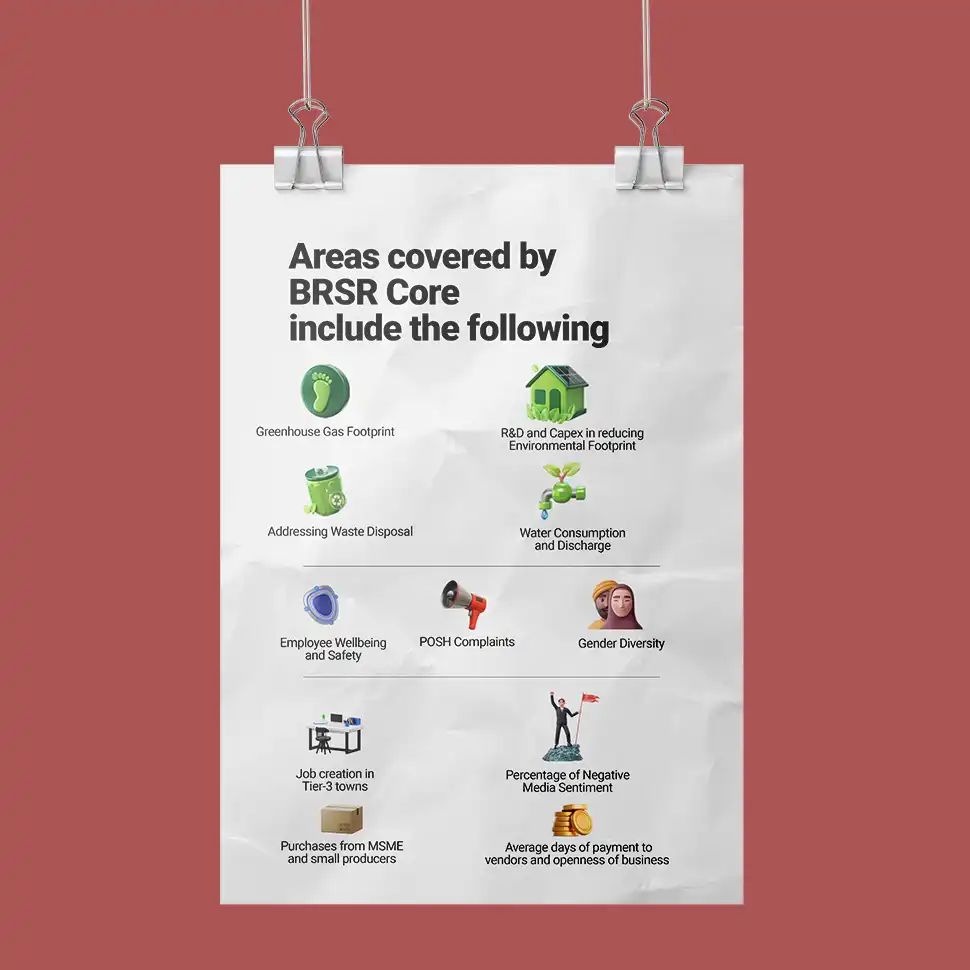
The Indian government has made major investments towards renewable energy sources, such as solar, wind and hydropower. This has enabled the country to move towards clean energy and reduce its reliance on expensive fossil fuels. It has also taken steps to protect its forests from deforestation and degradation and is working towards increasing its forest cover. The government has also set up several funds and incentives for businesses to help them transition to green technologies and become more sustainable. This includes the National Adaptation Fund on Climate Change, the Patents Facilitation Fund and the Low Carbon Technologies Fund among others.
One of its latest efforts in that direction is introduction of Environment, Social and Governance (‘ESG’) framework which include guidelines on ESG disclosures/reporting, ESG rating, and ESG investing.
The New ESG Framework
1. Background
It has been more than a decade since the introduction of sustainability reporting in India. In 2011, the Ministry of Corporate Affairs (‘MCA’) released National Voluntary Guidelines on Social, Environmental and Economic Responsibilities of Businesses (‘NVG’) which was then further adopted and mandated by the Securities and Exchange Board of India (‘SEBI’) through introduction of Business Responsibility Reports (‘BRR’) for top 100 listed companies. The trend has been gaining momentum ever since and, in December 2019, SEBI extended the BRR requirement to the top 1000 listed companies by market capitalisation.
In view of the global trends, a need was felt that it would be useful to analyse the nature of disclosures being made by companies in the SEBI-BRR Reports and make them more responsible and accountable towards the society. Based on the globally accepted parameters, MCA adopted the National Guidelines for Responsible Business Conduct (‘NGRBC’) in 2020. Subsequently, SEBI replaced BRR with Business Responsibility and Sustainability Reporting (‘BRSR’) formulated by an MCA committee on BRR.
The BRSR so far was only voluntary and the lacked reliability and accountability. Therefore, given the importance ESG is gaining in the recent times, SEBI has introduced a detailed ESG framework to make the businesses more accountable, responsible and transparent towards the ecosystem in which it operates.
2. ESG framework by SEBI for ESG Disclosures, Ratings and Investing
In order to streamline the regulatory framework for ESG Disclosures, ESG Ratings in the securities market and ESG Investing by Mutual Funds, SEBI had invited public comments through consultation paper issued on 20 February 2023. The same was in principle approved by SEBI on 29 March 2023
The proposal as well as the final framework is summarised as under:
2.1. ESG Disclosures by Listed Entities
Mandatory disclosure for top 1000 listed companies – With effect from financial year (‘FY’) 2022-23, SEBI has mandated ESG disclosures for top 1000 listed companies (by market capitalization) to make ESG disclosures as per the BRSR.
BRSR Core Assurance – With focus on improving credibility and limiting the cost of compliance, the ESG Committee (‘the Committee’ or ‘the ESC’) of SEBI had proposed for reasonable assurance of the most critical disclosures of BRSR which shall be termed as ‘BRSR Core’. The reasonable assurance for such key performance indicators (‘KPIs’) was proposed in a phased manner in consultation paper:
| FY 2022-23 | FY 2023-24 | FY 2024-25 | FY 2025-26 |
| Mandatory reporting for top 1000 companies; Reasonable assurance on BRSR Core– no mandatory requirement | Reasonable assurance on BRSR Core– mandatory for top 250 companies | Reasonable assurance on BRSR Core-mandatory for top 500 companies | Reasonable assurance on BRSR Core –mandatory for top 1000 companies |
However, SEBI, in its press release dated 29 March 2023, has prescribed for applicability of BRSR Core beginning with the top 150 listed entities (by market capitalization) from FY 2023-24 which shall be gradually extended to the top 1000 listed entities by FY 2026-27. Furthermore, the press release does not address the specific questions on which public comments were invited in the consultation paper.
The KPIs in BRSR Core are more quantifiable relevant for both manufacturing and services sectors and contains intensity ratio to enable comparability, irrespective of the size of the company. Furthermore, for global comparison, the ESG Committee also recommends country level Purchasing Power Parity (PPP) adjustment in intensity ratios.

ESG Disclosures for supply chain – At present, the metrics related to the supply chain of a company are covered under leadership indicators in the BRSR that may be reported on a voluntary basis. Since the significant ESG footprint of any company may be found in their supply chains, it becomes imperative to classify them from leadership indicator (voluntary disclosure) to the essential indicator (mandatory disclosure).
However, owing to the complexities involved such as large number of small supply chain partners, unlisted firms, multiple tiers of suppliers within the supply chain, etc., it is proposed to introduce BRSR Core in gradual manner on a ‘comply or explain basis’ as follows:
| FY 2024-25 | FY 2025-26 |
| The parameters under BRSR Core are also be required to be disclosed for entire supply chain by top 250 companies (by market cap) on a “comply or explain” basis. Assurance not mandatory | The parameters under BRSR Core are also be required to be disclosed for entire supply chain by top 250 companies (by market cap) on a“comply or explain” basis Assurance on ‘comply or explain’ basis |
2.2. ESG Ratings by ESG Rating Providers (‘ERP’)
Rating parameters in Indian context: The ESC has recommended a list of 15 Indianized ESG parameters in order to bring consistency and assist ERPs in adopting a common approach for rating. These parameters are based on three pillars of ESG broadly encompassing following parameters:
| Environment |
|
| Social |
|
| Governance |
|
Ratings on assured BRSR Core parameters: In general, the ESG ratings are assigned based on self-reported data by corporates. The ESG Committee further proposes that in addition to their general ESG ratings, ERPs shall also provide a Core ESG rating which shall be based on information/reports that are assured/audited/verified.
2.3. ESG Investing by Mutual Funds/Asset Management Companies (‘AMCs’)
| Stewardship reporting beyond the existing stewardship code1 | Effective from | |
| Voting disclosures | In order to bring more transparency on voting by Mutual Funds/AMC, disclosures have been proposed for ‘in favour’ or ‘against’ votes cast in a year if the resolution has or has not been supported due to any environmental, social or governance reason. | FY 2023-24, i.e., for annual general meetings held from 1.04.2023. |
| Mitigation of risk of mis-selling and greenwashing at scheme level | Effective from | |
| Investment criteria | ESG scheme shall invest atleast:
|
1 October 2024 Further extended by 1 year, i.e., till 30 September 2025 during which no fresh investments without BRSR Core disclosures should be taken up until the criteria is met. |
| Monthly portfolio disclosure | Security-wise BRSR Core rating/score shall be disclosed in monthly portfolio disclosure. | NA |
| Reasonable Assurance by third party | To ensure scheme portfolio being in compliance with stated policy and objective, reasonable assurance has been proposed by the Committee. | 1 April 2023 on “comply or explain” basis. 1 April 2024 onwards – may be made mandatory. |
| Certificate by Mutual Fund | A certificate based on internal audit by the mutual funds may also be mandated in order to ensure authenticity of claims made in various documents of ESG fund. | 1 April 2023 |
| Classification of ESG Schemes | Effective from | |
| ESG Schemes subcategory | AMC have been permitted to launch one ESG scheme under each of the 5 subcategories/themes – exclusions, integration, best-in class & positive screening, impact investing and sustainable objective. To accurately reflect the nature and extent of ESG schemes, it has been proposed to mandate the AMCs to include the name of the particular ESG strategy in the name of the concerned fund/scheme, such as, XYZ ESG Exclusionary Fund, ABC ESG Best-in-class Fund etc, etc. | Such naming requirement may be mandated from 1 April 2023 |
| Minimum investment | At least 80% of total assets in equity/debt stocks of a particular theme. | NA |
| Other proposals | Effective from | |
| Disclosure of ERP | It has been proposed to mandate the disclosure of ERP alongside the ESG score in monthly portfolio disclosures. | 1 April 2023 |
| Annual fund manager commentary | It is proposed that under the Fund Disclosures, annually a section of ‘Fund Managers’ Commentary may be added which may highlight the following:
|
1 April 2024 onwards |
3. Our take
India has been at the forefront in adopting forward looking measures for quite some time now. This is necessary to keep up the pace with the ongoing changes. One of them is ESG framework, which, inter alia, require businesses to act responsible and disclose the efforts made by them towards ESG. While the intent is there to ensure sustainability, inclusivity, diversity, transparency in the business operations, its implementation will play a key role in ensuring its effectiveness.
1. The mutual funds/AMCs are required to follow mandatorily a stewardship code which inter-alia includes having a clear policy on voting, compulsory voting in respect of resolutions including social and corporate responsibility issues, etc.











